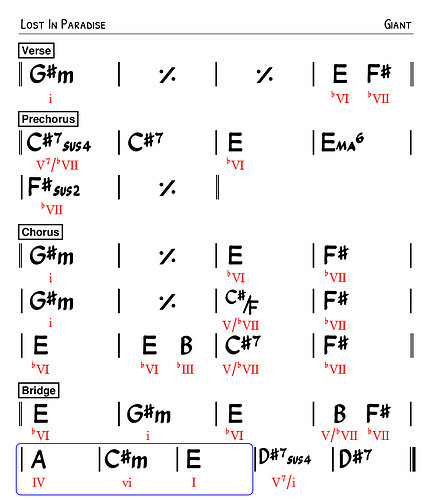Here’s a classic 80’s song by one of my favourite guitarists/bands (Dann Huff/Giant) that I’ve been working on with a private student to help improve on a mixture of phrasing techniques and sense of harmonic awareness. I’m going to share my harmonic analysis here too and hopefully some of you will enjoy it!
Here’s the song in reference:
Below is each section of the song, along with timestamps to support my analysis. See the chord chart at the bottom of this post for the chords.
The song is in the key of G#m.
 Chord Chart
Chord Chart
 Harmonic Analysis
Harmonic Analysis
 Verse (0:00 - 0:52)
Verse (0:00 - 0:52)
This progression is a very common and standard minor rock/Aeolian progression. The overlaying arpeggios add a suspended flavour to the chord voicings, which I think gives this a sense of deep-thought and mystery.
G#m(sus2) and F#(sus4) are what the arpeggios add onto the progression.
 Prechorus (0:52 - 1:05)
Prechorus (0:52 - 1:05)
The C#7sus4 makes the transition to the C#7 more forgiving. The C#7 acts as a secondary dominant of the F#, but takes a minor detour via the bVI (E) before the inevitable resolution to F#.
This section finishes on F#sus2 which adds a lot of suspense and anticipation for the climactic chorus. This is the bVII, which as expected will resolve to the tonic chord.
 Chorus (1:05 - 1:32)
Chorus (1:05 - 1:32)
The first 4 bars of the chorus outline the same progression used in the Verse. The second 4 bars use the same progression, but to begin leading the listener on a journey beyond what we expect to hear you’ll notice the secondary dominant substitution in place of the bVI. This chord is voiced in its first inversion which helps the bassline walk smoothly from F to F#.
On the 9th bar of the Chorus, E, this is where the progression offers an uplifting and hopeful tone. That’s because this set of 4 chords begin on the keys relative major. The B is a V above E, and upholds the uplifting major tonality. Then you’ll see the V7/VII again, resolving to F#, which sets up a steady resolution to the tonic at the beginning of the Verse. The C#7 is softened by a preceding C#7(sus4) - I forgot to note that on the chord chart.
 Bridge (2:43 - 3:03)
Bridge (2:43 - 3:03)
The Chorus prior to the bridge ends on the tonic chord for a sense of stability before we leap to the relative major (E). One might argue that the entire bridge is in the key of E. Another possibility is that it’s all in G#m with the exception of the single A chord. For me, my ear does not depart from G#m until the A chord. The A presents a very clear and obvious harmonic shift in the music. I’ve notated the chords in the blue box according to the key of E because it makes the most sense to me, and it’s clear that whilst E major is not the tonic of the Bridge, it’s at least attempting to pose as the tonal centre.
The B - F# helps modulate to the A chord which begins our brief departure into the key of E major. The notes of F# are quite similar to A. In fact, if you think of the A chord as an F#m instead, the F# - F#m (A) outlines a major-minor plagal cadence towards the C#m chord. Then the C#m is a stable submediant, which shares the majority of its notes with the E (I). Finally we re-assert the key of G#m again with D#7(sus4) to D#7. The D#7 has a strong pull towards the G#m. The transition between E and D#7 is softened once again with the passing sus4 voicing.
 Solo (3:03 - 3:30)
Solo (3:03 - 3:30)
Same progression as the Chorus
I hope you enjoyed this analysis! Let me know if you have any questions or corrections! ![]()

